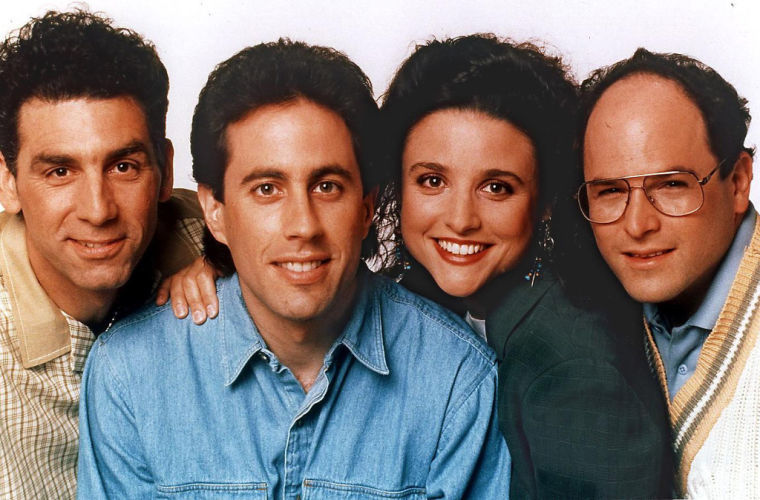
Seinfeld
It began — and would later end — with a conversation about a shirt button. The second button, to be specific. You see, that’s the crucial button.
“The second button literally makes or breaks the shirt,” Jerry Seinfeld explains to his best friend George in the middle of a coffee shop, during the first episode of what would become one of the greatest shows in television history. “Look at it,” Jerry says, pointing to the button like it’s the only thing in the world in that matters. “It’s too high. It’s in no-man’s land; you look like you live with your mother.”
As I write this, the Seinfeld complete series box set sits close by at the foot of my television, a spot that it has occupied for some time now. It contains 32 DVDs, is quite heavy and is designed to look like a small refrigerator. It came with an episode guide and a coffee table book and will forever remain one of the greatest gifts I have ever received.
On many summer nights, drowned with fatigue from my seasonal experience as a member of America’s workforce, I turn to Seinfeld, despite having seen every episode, to lighten my mood. This idea, the one of Seinfeld as an antidote, is a common one. The story goes that, as he filmed Schindler’s List, Steven Spielberg, too, would turn to Seinfeld reruns to cheer himself up. Seinfeld himself called hearing that story “one of the greatest moments in the history of the show.” On my commitment, Seinfeld has not yet made comment.
Choosing an episode is never hard, because the episode doesn’t matter. They are all brilliant, with the exception of a few from season one, as Seinfeld and co-creator Larry David found their footing. (Five of my favorites in no particular order: “The Switch,” “The Race,” “The Wait Out,” “The Opera” and “The Boyfriend”).
Each 21 minutes usually presented a brand-new set of storylines carefully woven together, as the show featured very few continuous narratives. The only time one of the characters found themselves in a serious relationship, the writers employed death by envelope to put the kibosh on it. This inconstant approach to the lives and interests of its characters not only gave Seinfeld immense rerun value (you never need to catch up on anything), it also gave the show a platform on which to lampoon the unpredictable landscape of 30-something single life.
But there are other reasons none of the characters ever formed real relationships. If you think about it, all the main characters on Seinfeld — Jerry, Elaine, George and even Kramer, a character so popular that producers had to ask the live taping audience to stop clapping every time he entered a scene because it messed up the actors’ timing — were pretty terrible people. Callous, critical and vain, Jerry Seinfeld was one of the first in a long list of television anti-heroes that has since been dominated by the dramatic likes of Don Draper and Tony Soprano.
But none of this mattered to the viewers; we loved them all the same. We didn’t find them rude or offensive because we were on their team. Sometimes it feels good to be the people who take that handicapped parking spot (“The Handicap Spot”) or laugh at someone getting jumped (“The Finale”).
Another unique aspect of the series is its somewhat allergic reaction to television norms. The show’s creators purposefully avoided catering to the viewer by giving the characters redeeming qualities or writing in neat, tidy episode endings. Seinfeld was also never concerned with being politically correct; in fact, some of its best episodes are its most controversial: “The Puerto Rican Day,” “The Jimmy,” and “The Contest.” The show’s real strength is that it could satirize something as trivial as low talkers (“The Puffy Shirt”) and then take on an issue like racial friendships (“The Diplomat’s Club”), managing to make them equally hilarious.
Throughout all of the little adventures the show explores, the one constant, the true heart of the show, are the four main characters: Jerome, Laney, Georgie Boy and Cosmo. Theirs is a friendship of such casual affection and effortless collaboration, an aspect of the show more enviable than Jerry’s Upper West Side abode.
So, as I raid that small refrigerator with the eagerness of Kramer in his favorite neighbor’s apartment or Newman in search of jambalaya, I do so in an effort to return to somewhere familiar and funny. For nine seasons, Seinfeld invited America into Jerry’s apartment, a place where we could look down at the rest of the world and just laugh. It was a place to be among friends.
In the final scene of one of the best shows in television history, Jerry Seinfeld points to a button on his best friend George’s shirt. The second button, to be specific. “See now, to me, that button is in the worst possible spot,” he begins.
“Haven’t we had this conversation before?” George asks.
They have, but it doesn’t matter. The beauty of Seinfeld is that it never really mattered. The show lived and breathed not through what its characters said, but through what they were and that is — undoubtedly, concretely, triumphantly — something.



